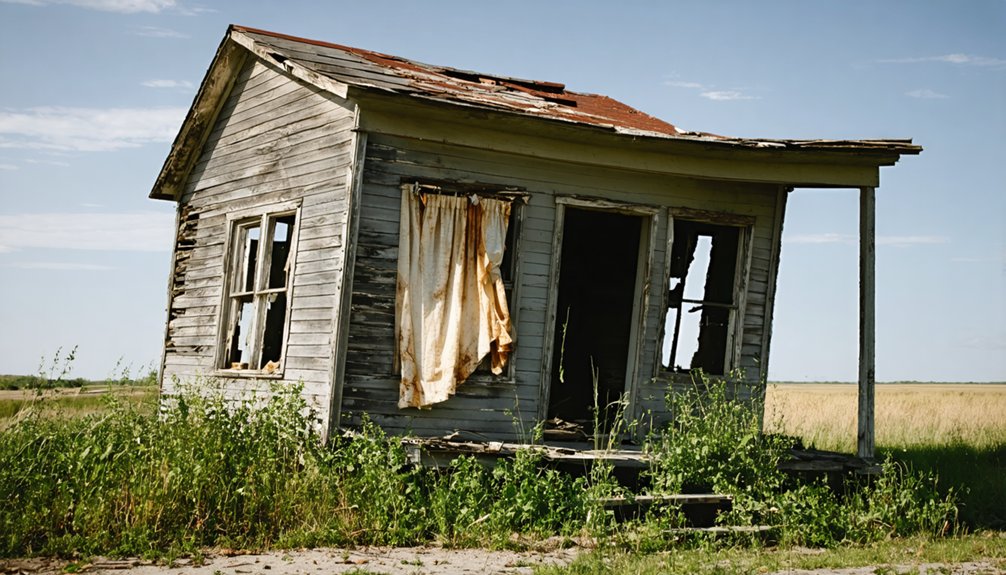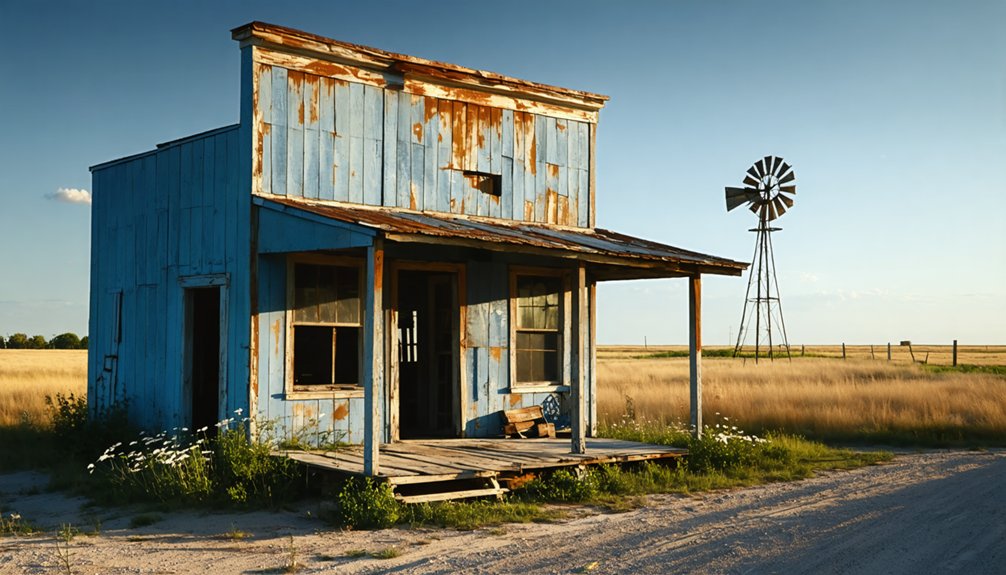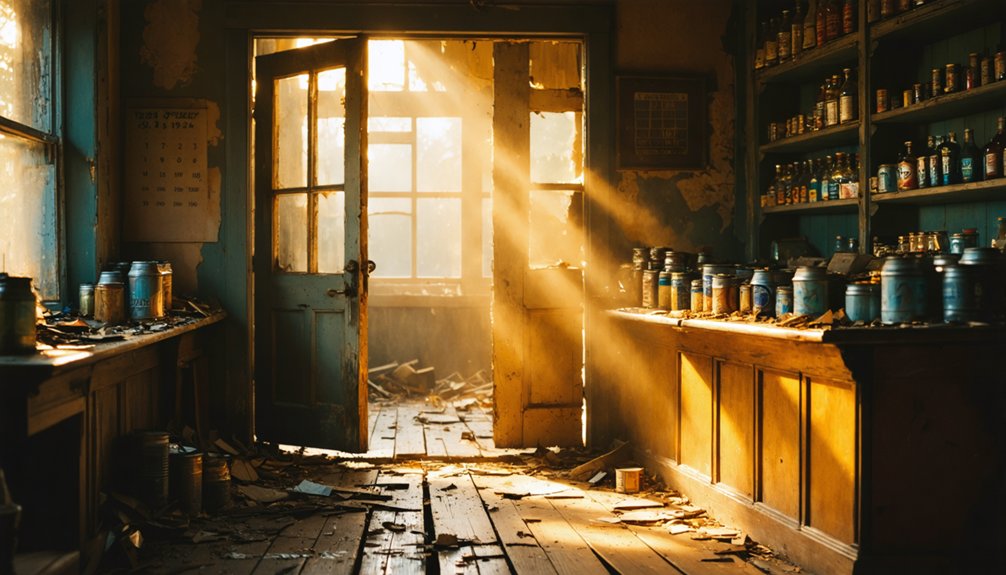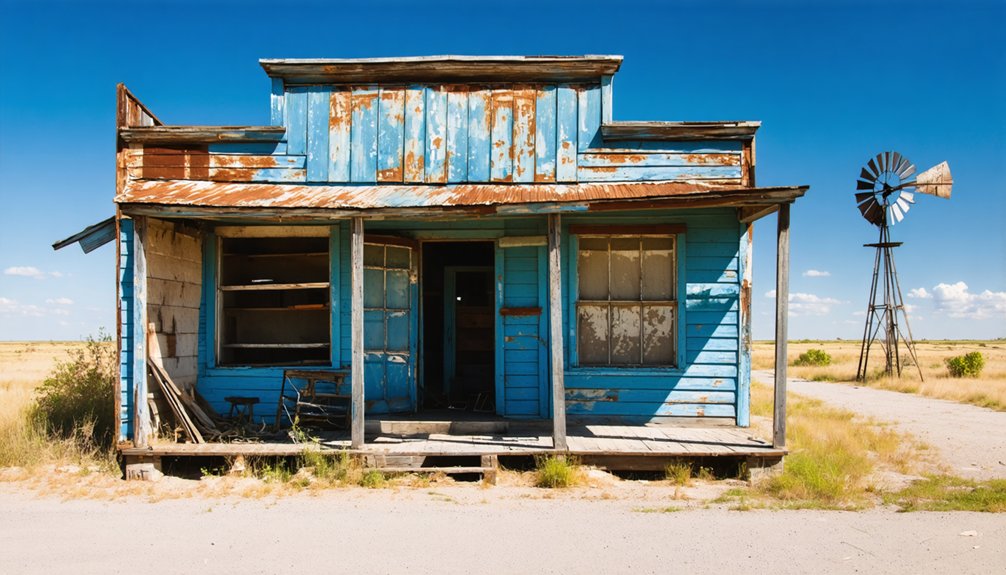You’ll find Huron’s remains in Texas’s northern plains, where it once thrived as a bustling agricultural settlement. The town’s fortunes rose with the arrival of the Chicago, Rock Island and Gulf Railway in 1906, transforming it into a crucial transport hub for cotton and corn farming. Economic forces, including reduced rail service and highway development, gradually emptied the town over three decades. Today, abandoned buildings and railway remnants tell a deeper story of rural Texas’s transformation.
Key Takeaways
- Huron transformed from a thriving agricultural and railroad hub in the early 1900s to a ghost town through decades of economic decline.
- The town’s decline accelerated when railway services reduced and highways were rerouted, diverting commerce and population away.
- Housing prices fell 35% over two years, with rental rates dropping from $1,500 to $900 monthly during the exodus.
- The community’s population dwindled from thousands to hundreds as younger generations left and essential services disappeared.
- Historical remnants include abandoned railway depots, tracks, and buildings that serve as testimony to Huron’s former prosperity.
The Birth of an Agricultural Dream
While many Texas towns emerged from railroad junctions or cattle trails, Huron’s story began with an agricultural vision that drew pioneering families to Terry County’s open plains.
Like the workers of the once-a-month paycheck system found in company towns, farmers often had to carefully manage their income between harvests.
You’d have found these early settlers establishing their farms on fertile soil perfect for cotton and corn cultivation, implementing farming techniques suited to the South Plains region.
The community’s promise grew as cotton gins sprang up, creating essential infrastructure for processing raw cotton efficiently.
You could’ve witnessed the emergence of farming cooperatives sharing knowledge and resources, while agricultural supply stores opened to serve the growing population.
Despite the region’s climate challenges, farmers adapted their crop diversity to maximize the long growing seasons.
The agricultural dream fostered a spirit of independence, as accessible land and favorable conditions beckoned those seeking prosperity through farming.
Similar to many of the 511 ghost towns scattered across Texas, Huron’s population gradually declined as economic conditions changed.
Railroad Prosperity and Early Growth
The arrival of railroad lines in Texas marked a new chapter for agricultural communities like Huron.
Cotton and agriculture could be transported more efficiently once rail service arrived, transforming the region’s economy.
You’ll find that railroad expansion transformed travel and commerce, cutting journey times dramatically while slashing freight costs by half compared to traditional transport methods. What once took days by stagecoach could now be completed in mere hours. Before railroads, merchants paid twenty cents per ton mile to transport goods by wagon across difficult terrain.
The economic impact on Huron was substantial as the town benefited from the expanding rail networks of the 1870s.
Rail expansion in 1870s Huron proved transformative, turning the small Texas town into a flourishing center of commerce and trade.
You could now ship agricultural products to distant markets more efficiently, and the town’s proximity to major rail routes helped establish it as a regional trade hub.
The Houston and Texas Central Railway’s northward push, combined with connections to interstate lines like the Missouri-Kansas-Texas Railroad, opened new opportunities for growth and commerce in small Texas communities like Huron.
Daily Life in Historic Huron
In historic Huron, you’d find the heartbeat of daily social life centered around essential gathering spots like the saloons and eateries where workers congregated after their shifts.
Similar to German immigrants who fled coastal devastation and relocated after natural disasters, many of Huron’s residents adapted by moving to more prosperous areas over time.
Your workday would have revolved around the demanding schedule of mining or railroad operations, with most commercial and social activities taking place during evening hours and weekends.
You could have supplemented your primary employment income through small-scale farming or trading at local shops that served the working population. Like many Texas towns facing economic changes, Huron’s population dwindled as industries shifted and residents sought opportunities elsewhere.
Community Gathering Places
Life in historic Huron revolved around key community gathering places that served multiple social functions.
You’d find daily community interactions at Hicks-Cobb general store, where residents exchanged news while shopping. Similar to Medicine Mound’s Hicks-Cobb general store, these retail establishments were vital social hubs. The local post office doubled as an informal hub where social memories were formed through shared stories and updates.
Churches, schools, and ethnic meeting halls formed the backbone of organized gatherings, hosting everything from town meetings to cultural celebrations. Immigrant communities from Poland, Italy, Britain, and Ireland enriched these spaces with their diverse customs and traditions. Similar to Thurber’s dynamic growth, the town provided full electric services to support these community venues.
The town’s public spaces – from simple sidewalks to cemetery grounds – fostered spontaneous encounters between neighbors. Even practical stops like gas stations and banks became impromptu social venues where you’d catch up on local happenings while conducting daily business.
Work and Trade Patterns
While mining operations dominated Huron’s economic landscape, daily work patterns centered around the Texas and Pacific Coal Company‘s tightly controlled industrial system.
You’d find yourself working long hours in dangerous conditions, receiving your wages monthly – often in company scrip rather than real currency. This labor exploitation meant you could only spend your earnings at the company store, creating a cycle of trade dependency that kept you tied to the company’s economic control.
If you were a miner, you’d face strict oversight of your movements, with the company town sometimes fenced off with barbed wire to keep union organizers out.
Independent merchants couldn’t compete, and your ability to seek better opportunities was severely limited by this controlled environment that prioritized industrial productivity over workers’ rights. Like many rural Texas towns, the area eventually declined as workers sought better opportunities in larger cities with more diverse economic prospects. Many workers hastily abandoned their homes during the exodus, leaving behind hidden treasures that still intrigue modern explorers.
Notable Buildings and Landmarks
Among Huron’s most significant historical structures stands the 1872 stone courthouse and jail complex, which once served as the administrative heart of Frio County. The architectural styles reflect frontier Texas masonry techniques, while the jail’s notoriety stems from housing infamous outlaws like Sam Bass and Jesse James, adding to its cultural significance.
You’ll find remnants of early commercial life through wooden storefront foundations and the former post office ruins. Stone chimneys and building foundations mark where settlers’ homes once stood, creating a visible footprint of neighborhood clusters.
The town cemetery remains one of the best-preserved sites, featuring historic gravestones and wrought iron fences that document early settler families. State historical markers and monuments throughout the site help visitors understand Huron’s pivotal role in Texas frontier history.
The Gradual Decline and Exodus

Like many Texas ghost towns, Huron’s decline stemmed from economic forces that gradually drained the town’s liveliness over several decades.
You’ll find that the closure of transportation hubs and rerouting of major highways diverted essential commerce away from the community, while the loss of local industries removed incentives for residents to stay.
The population steadily dwindled as families relocated to areas with better job prospects and modern amenities, leaving behind empty buildings as silent witnesses to the town’s former prosperity.
Economic Forces Behind Exodus
As the oil and energy sector contracted in Texas during the late 20th century, Huron experienced a devastating economic downturn that triggered its eventual abandonment.
You’d have witnessed massive economic migration as oil companies scaled back operations, leaving workers without stable income. Housing prices plummeted by 35% over two years, while rental rates dropped from $1,500 to $900 monthly, signaling a severe housing crisis.
The town’s vulnerability became apparent as foreclosures surged 40% year-over-year. Without economic diversity, Huron couldn’t sustain its population when agricultural productivity declined and infrastructure projects stalled.
You’d have seen local businesses shutter as consumer bases shrank, while property owners struggled to sell homes that lingered on the market for over 90 days, forcing many to slash prices or abandon their properties entirely.
Population Loss Over Decades
The gradual exodus of Huron’s population unfolded across three distinct decades, transforming from a vibrant community into a shell of its former self.
You’ll find this pattern mirrors other West Texas communities, where demographic shifts have steadily eroded once-thriving populations from thousands to mere hundreds.
Rural isolation intensified as essential services vanished – schools closed their doors, post offices shuttered, and medical facilities disappeared.
The town’s aging residents found themselves increasingly cut off, while younger generations sought opportunities elsewhere.
The cycle became self-perpetuating: as more people left, more services disappeared, prompting further departures.
Census data tells the stark story of Huron’s decline, part of a broader trend affecting 75 Texas counties between 2022 and 2023, particularly in the High Plains region where ghost towns now dot the landscape.
Legacy of the Railway Era
During its heyday, Huron’s identity was inextricably linked to the Chicago, Rock Island and Gulf Railway, which arrived in 1906 and transformed this Texas settlement into a bustling transport hub.
You’ll find railway symbolism woven throughout the town’s history, from the rhythmic schedules that once governed daily life to the cultural nostalgia that persists in local folklore and ghost stories.
The railroad’s influence extended far beyond mere transportation, shaping everything from agricultural prosperity to social interactions.
While you can still spot remnants of this railway heritage in abandoned depots and weathered tracks, they’re now silent testimonies to Huron’s former glory.
The town’s eventual decline, triggered by reduced rail service and highway development, mirrors the fate of numerous Texas communities that couldn’t survive the shift from rail-dependent commerce.
Preserving Huron’s Heritage Today

Modern preservation efforts in Huron center around community-driven initiatives that breathe life into this Texas ghost town’s rich heritage. Local volunteers and historians lead heritage conservation projects through restoration work, artifact collection, and historical documentation.
- Digital archives preserve photographs, maps, and oral histories, ensuring Huron’s story endures even as physical structures fade.
- Historical markers and interpretive signage guide visitors through key sites, linking the town’s past to broader regional developments.
- Community involvement flourishes through periodic events, reenactments, and fundraising efforts that support ongoing preservation.
You’ll find Huron’s legacy increasingly woven into regional heritage tourism trails, with nearby communities promoting visits as part of the East Texas historical experience.
Academic partnerships and historical societies provide essential support, helping authenticate preservation projects and secure necessary resources.
Life Stories From Former Residents
Personal accounts from Huron’s former residents paint a vivid portrait of life in this company-controlled mining town, where immigrant workers faced both opportunities and harsh realities.
You’ll find stories of remarkable immigrant resilience, like the Polish miner who spent 30 years working the Thurber mines while showcasing his mastery as a brick mason.
Despite living behind barbed wire fences under armed guard supervision, residents forged strong community bonds through their shared experiences and cultural traditions.
Workers endured grueling conditions in the mines, battling coal dust and physical dangers while supporting their families.
When oil replaced coal and the economy collapsed, many faced heart-wrenching decisions to abandon their homes.
Through their preserved artifacts and local cemeteries, you can still trace the legacy of these determined immigrants who shaped Huron’s identity.
Exploring the Ghost Town’s Remains

Today’s visitors to Huron’s ghost town will encounter compelling remnants of its mining past, from weathered commercial structures to the haunting cemetery grounds.
You’ll find ghostly architecture in the form of abandoned stores, a bank building, and skilled masonry work, including a distinctive 1913 brick wall crafted by a Polish immigrant miner.
- Explore the historic cemetery with its weathered iron fencing and multicultural headstones that tell stories of the diverse mining community.
- Discover mining artifacts scattered throughout, including remnants of smokestacks and company infrastructure.
- Examine the original barbed wire perimeter that once controlled access to this company town.
As you navigate the abandoned streets, you’ll notice foundational footings and architectural details that reveal the town’s early 20th-century design, though many structures now succumb to time and elements.
Frequently Asked Questions
Are There Any Reported Ghost Sightings or Paranormal Activity in Huron?
Ever wonder what lurks in abandoned places? While you’ll find spectral legends and local ghost stories, there’s no officially documented ghost encounters in Huron, though oral traditions mention shadowy figures and unexplained sounds.
What Was the Peak Population of Huron During Its Most Prosperous Years?
You’ll find that Huron’s peak population reached approximately 150 residents before economic factors triggered a population decline, eventually dropping to just 12 people by 2000 as rural opportunities diminished.
Did Any Famous Outlaws or Historical Figures Ever Visit Huron?
You won’t find documented outlaw encounters or historic visitors in Huron’s records. While Texas ghost towns often intersect with famous figures, there’s no evidence of notable personalities ever stopping here.
What Natural Disasters or Severe Weather Events Impacted Huron’s History?
Precisely pinpointing proven natural disasters affecting Huron is challenging, as there aren’t documented flood damage or hurricane impact records. You’ll find general regional threats like droughts and storms likely affected the area.
Were There Any Native American Settlements in the Area Before Huron’s Founding?
You’ll find evidence of Cherokee, Caddo, and other Native American tribes in East Texas before Huron’s founding, though cultural exchange was limited due to forced relocations by Texas authorities.
References
- https://www.hipcamp.com/journal/camping/texas-ghost-towns/
- https://www.amysatticss.com/ghost-towns/
- https://texashighways.com/travel-news/four-texas-ghost-towns/
- https://www.youtube.com/watch?v=phjUE19A8HM
- https://www.southernthing.com/ruins-in-texas-2640914879.html
- https://en.wikipedia.org/wiki/List_of_ghost_towns_in_Texas
- https://www.texasescapes.com/CentralTexasTownsNorth/HuronTexas.htm
- https://www.tshaonline.org/handbook/entries/huron-tx
- https://www.michigansthumb.com/news/article/ghost-towns-thumb-port-crescent-18420020.php
- https://www.texasstandard.org/stories/texas-population-boom-ghost-towns-rural-urban-suburban-shift/



